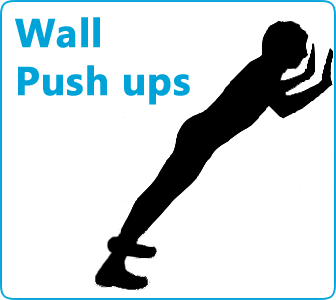As simple as it may seem, a wall push up is very similar to a standard push up except it is performed in a standing position using a flat wall and body weight as resistance.

Wall push up’s are usually used as a beginners exercise and can easily be included as a pre workout warm up or a post work out cool down. For many the concept of doing push ups against a wall is a little hard to grasp, however the exercise is a great starting block, particularly for those who struggle with standard push ups.
One of the main advantages of a wall push up is that it exerts zero pressure on the back muscles whilst working the pectoral (chest) muscles, ideal for those with back issues. However, despite being very popular and relatively easy to perform, the advantages of wall push ups are fairly small in relation to regular push ups.
One of the main disadvantages of wall push ups is that they do not require the body to work against the force of gravity, limiting their effects. Standard push ups have proven to give greater results because the individual is not only required to use their own body weight as resistance but also the force of gravity.
Another small disadvantage is the muscles which are targeted; wall push ups predominantly target the pectorals, dismissing the core muscles. Standard push ups on the other hand can be adjusted to target specific muscles.
On a positive note wall push ups are perfect for pregnant women and anyone that is over weight and unable to complete a regular push up.
How to perform a wall push up
Like standard push ups wall push ups are quite easy to perform, it is important however to adopt the correct technique. Firstly you should stand up straight with your whole body facing a flat bare wall; your body should be no more than eight inches away from the wall. Next, place your hands on the wall, palm first, fingertips pointing upwards and hands slightly wider than your shoulders.
Next, slowly move your feet back away from the wall, your feet should now be about a foot away from the wall and your arms should be slightly bent. It is very important at this stage that you keep your back straight; this should be the case throughout the whole exercise.
At this point you will have adopted the standard wall push up position, in theory this is a vertical adaptation of the standard push up position. From here all you are required to do is bend your arms, bringing your head and upper body close to the wall.
This is the basic action of a wall push up and one which can be performed time and time again. As with any weight resistance exercise you should look to inhale when your muscles are relaxed (elbows straight) and exhale when your muscles are working (elbows bent). Adopting this type of breathing pattern will be useful when looking to perform a number of these push ups over a small period of time.